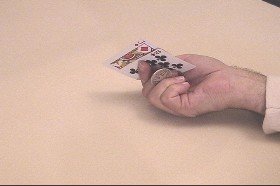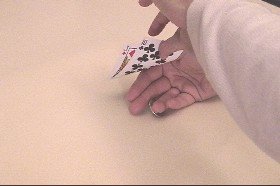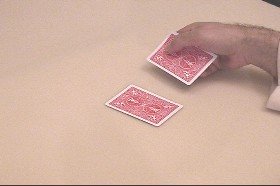thumb can push off another card from the top of its packet to the left.  As the As the |
| thumb pushes the card, it is slid over the first finger of the right hand. That finger |
| insures that only one card is pushed off the top. This picture shows an under view. |
| In this figure, the top card has been extended while the fingers remain curled. Move |
| that hand toward the table. As the hand nears the table, the fingers, holding the |
| concealed coin, extend a bit, allowing the edge of the concealed coin to hit the surface |
of the table  (view from under). The concealed coin is snapped forward onto (view from under). The concealed coin is snapped forward onto |
the table under cover of the extended card.  Just as before, the right thumb Just as before, the right thumb |
| releases the top card and moves to the right a bit to hold the other cards against the |
| hand. The right hand is moved suddenly to the right allowing the top card to fall onto |
the table.  From the audience point of view you placed a card on the table. In From the audience point of view you placed a card on the table. In |
| reality, you placed a card onto the table over a coin unknown to the audience. |
| To do the pick-up move the card is placed on top of a coin so the edge of the coin |
| touches the edge of the card. You can get to this position easily by holding the card |
| with the thumb and second finger at the long edges of the card. Then place the card on |
| the coin so the thumb touches the coin. When the card is released, both will be lined |
|
|      |




